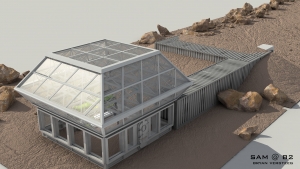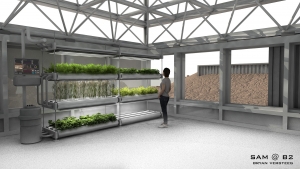July 2021 – May 2022
We returned to the development of a higher fidelity simulation with increasingly engaged agent interactions, introduction to staggered crop rotation, a foundation for tracking food nutrition, advanced life cycle plant growth functions, a foundation for random variation and total system entropy, and improved server-side management of agent definitions and data for a more dynamic, rich experience with even greater potential for non-linear outcomes and simulation of the real world. An interactive, 3D view of the exterior of the habitat was introduced to both the Configuration Wizard and simulation Dashboard.
In conjunction with construction of the hermetically sealed Mars habitat analog SAM at Biosphere 2, a SAM Configuration preset was added that closely approximates the real-world SAM habitat. A prototype for SIMOC Live was developed that enables real-time data to be gathered from environmental sensors (e.g. CO2, O2, temp, pressure) for life support systems monitoring in SAM. This was first demonstrated for the Analog Astronaut Conference hosted at Biosphere 2 in May 2022.
An Arizona State University, undergraduate Computer Science Capstone team has developed a means to capture live sensor data for presentation in the SIMOC interface and capture in the SIMOC back-end. Pressure, temperature, humidity, light levels, CO2 and O2 data at SAM will be made available to local, in-hab crew and to the world through the National Geographic hosted web interface. This ground-truth data will build a positive feedback loop ultimately moving to the application of reinforcement learning in an AI version of SIMOC for a future optimized control system of the SAM life support systems. These couplings of the model to the real-world experiment are imperative to any successful scientific endeavor.
Phase V SIMOC development includes:
- New agents and a preset configuration were added to simulate the SAM research facility being constructed at Biosphere 2.
- A 3D view of the habitat was added to the configuration and dashboard screens.
- Agent definitions, stored in JSON files and previously loaded into the SIMOC database on deployment are now loaded into the model directly at runtime, improving speed and paving the way for real-time custom agent definitions.
- Connections between agents are now specified in a separate JSON file, and include a ‘priority’ parameter such that, for example, human agents will eat fresh food when available, or else eat rations.
- Random variation of currency exchanges and randomly-occuring events were enabled, and are defined in new JSON files, ‘agent_variation’ and ‘agent_events’.
- ‘StorageAgent’ and ‘GeneralAgent’ are combined into a single agent, ‘GeneralAgent’, which can store currencies (as specified by per-currency capacity) and/or exchange currencies. This enables internal storage for active agents, such as plants accumulating internal biomass. It also entailed splitting the ‘air storage’ functionality between the habitat and greenhouse, and adding a new agent (‘atmosphere_equalizer’) to maintain a consistent pressure and composition between the two.
- A new class, ‘PlantAgent’ was defined to encapsulate lifecycle functions specific to plants, e.g. accumulated growth and harvest parameters. A growth multiplier based on ambient CO2 concentration also added to this class.
- The CO2 mitigation system was updated to include CO2 storage (for CO2 removed from the internal atmosphere by physico-chemical means) and a CO2 makeup valve (to release stored CO2 back into the internal atmosphere as necessitated by plant demand).
- Testing and documentation were added for the core ABM and the SIMOC web server.




